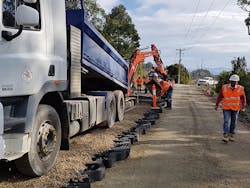Huon Valley Council is situated south of Hobart—the southernmost local government council in Australia. Esperance Coast Road was showing several signs of deterioration along its length, including deformation, cracks, and edge failure. To mitigate this, Huon Valley Council enlisted consultant Pitt & Sherry to undertake pavement investigations. Esperance Coast Road runs through a hilly area, with a high slope on one side and a valley on the other. High surface runoff and a lack of horizontal drainage caused the pavement to erode over time. Water accumulated in the pavement, which reduced the pavement layer’s structural capacity to support heavy traffic loads.
Consultant Pitt & Sherry and asset owner Huon Valley Council contacted Geofabrics, Presto’s material supplier, to help with a solution to control the water ingress and improve drainage. They recommended using the GEOWEB® 3D Soil Stabilization System to stabilize the base layer of the pavement, prevent degradation, and provide drainage. The Presto Geosystems design team developed a cost-effective solution for this problem. Based on pavement investigation, a subgrade CBR of 2% was considered in the preliminary evaluation.
A Geofabrics representative was on-site to provide installation assistance and support. The installers prepared the subgrade according to council specifications. A formation width of approximately 25 feet (7.6 meters) was suitable to install one panel of 6-inch (150 mm) GEOWEB in a transverse direction. The GEOWEB panels are connected with the patented ATRA Keys to provide positive connections between them.
One lane remained open to keep the traffic flowing while the project was underway. Half of the GEOWEB panel was expanded and secured with 20-inch-long (500 mm) pins. To create a horizontal drainage path through the GEOWEB-stabilized base course, 3/4-inch to 1 1/4-inch (20 mm to 30 mm) crushed aggregate was recommended and placed in the GEOWEB cells. Perforated GEOWEB cells offer high-flow capacity through the panel without compromising the structural capacity of the pavement material. Once filled, a 20-ton truck was easily placed over the aggregate-infilled GEOWEB panels without any deformation over the surface.
In total, 15,069 square feet (1,400 square meters) of the GEOWEB system was installed and infilled with crushed aggregate. The cellular confinement technology of the GEOWEB system improved the performance of the base layer, which also allowed the creation of a horizontal drainage layer without compromising the structural bearing capacity.
Compared to conventional methods, a GEOWEB-stabilized layer allowed pavement thickness to be reduced by 50%, further removing the number of truck movements to construct the road.
Editor's Note: Scranton Gillette Communications and the SGC Infrastructure Group are not liable for the accuracy, efficacy and validity of the claims made in this piece. The views expressed in this content do not reflect the position of the Roads & Bridges' Editorial Team.

